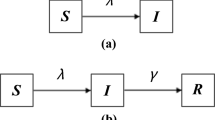Abstract
We numerically investigate the epidemic spread phenomena and efficient immunization strategies on complex networks embedded in geometry. It is assumed that there exists an unavoidable time delay (we call it the detection time) between the actual infection and the beginning of immunization, and we implement two different immunization strategies: one is based on topological connection neighbors (CN) of the infected vertex and the other on geographical spatial neighbors (SN). It is found that the decrease of the detection time is very important for a successful immunization. Our results suggest that within the limitation of the network models considered here, in which the infection probability is assumed to decrease with the geographic distance, the simple SN strategy works almost equally or better than the CN strategy, especially when the detection time is longer.
Access this chapter
Tax calculation will be finalised at checkout
Purchases are for personal use only
Preview
Unable to display preview. Download preview PDF.
Similar content being viewed by others
References
Barabási, A.-L., Albert, R.: Science 286, 509 (1999); Watts, D.J., Strogatz, S.H.: Nature 393, 440 (1998)
Boccaletti, S., Latora, V., Moreno, Y., Chavez, M., Hwang, D.-U.: Phys. Rep. 424, 175 (2006)
Diekmann, O., Heesterbeek, J.A.P.: Mathematical Epidemiology of Infectious Diseases: Model Building, Analysis and Interpretation. Wiley, New York (2000)
Anderson, R.M., May, R.M.: Infectious Diseases of Humans: Dynamics and Control. Oxford University Press, Oxford (1992)
Pastor-Satorras, R., Vespignani, A.: Phys. Rev. E 65, 036104 (2002)
Cohen, R., Havlin, S., ben-Avraham, D.: Phys. Rev. Lett. 91, 247901 (2003); Gómez-Gardeñes, J., Echenique, P., Moreno, Y.: Eur. Phys. J. B 49, 259 (2006); Holme, P.: Europhys. Lett. 68, 908 (2004)
Huang, L., Yang, K., Yang, L.: Phys. Rev. E 75, 036101 (2007); Huang, L., Yang, L., Yang, K.-Q.: ibid 73, 036102 (2006); Hayashi, Y., Matsukubo, J.: ibid 73, 066113 (2006)
Wang, B., Tang, H.-W., Xiu, Z.-L., Guo, C.-H.: Chin. Phys. Lett. 23, 3123 (2006)
Xu, X.-J., Wang, W.-X., Zhou, T., Chen, G.: Int. J. Mod. Phys. C 17, 1815 (2006); Xu, X.-J., Wu, Z.-X., Chen, G.: Physica A 377, 125 (2007)
Riley, S.: Science 316, 1298 (2007)
Rozenfeld, A.F., Cohen, R., ben-Avrahama, D., Havlin, S.: Phys. Rev. Lett. 89, 218701 (2002)
Brockmann, D., Hufnagel, L., Geisel, T.: Nature 439, 462 (2006)
Yook, S.-H., Jeong, H., Barabási, A.-L.: Proc. Natl. Acad. Sci. U.S.A. 99, 13382 (2002)
Gastner, M.T., Newman, M.E.J.: Phys. Rev. E. 74, 016117 (2006)
US Census Bureau, Census 2000: census of population and housing (DVD-ROM, 2003)
Author information
Authors and Affiliations
Editor information
Editors and Affiliations
Rights and permissions
Copyright information
© 2009 ICST Institute for Computer Science, Social Informatics and Telecommunications Engineering
About this paper
Cite this paper
Wang, B., Aihara, K., Kim, B.J. (2009). Immunization of Geographical Networks. In: Zhou, J. (eds) Complex Sciences. Complex 2009. Lecture Notes of the Institute for Computer Sciences, Social Informatics and Telecommunications Engineering, vol 5. Springer, Berlin, Heidelberg. https://doi.org/10.1007/978-3-642-02469-6_116
Download citation
DOI: https://doi.org/10.1007/978-3-642-02469-6_116
Publisher Name: Springer, Berlin, Heidelberg
Print ISBN: 978-3-642-02468-9
Online ISBN: 978-3-642-02469-6
eBook Packages: Computer ScienceComputer Science (R0)




